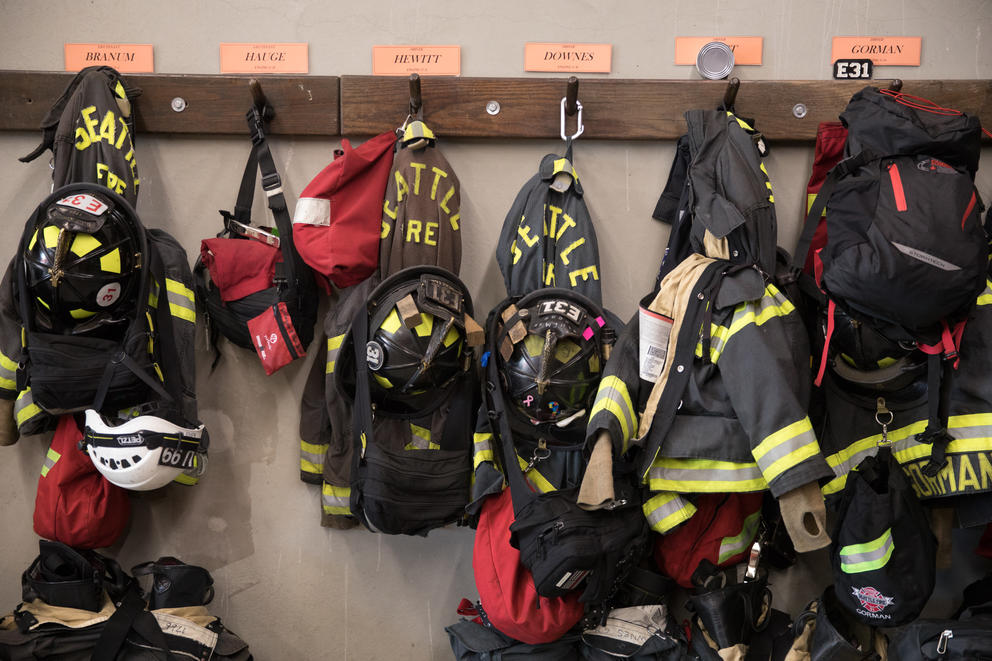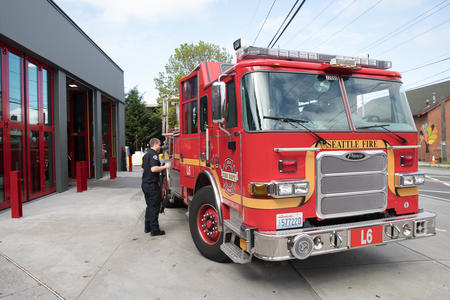Between June 18, when Station 31 — nicknamed the “cancer house” by firefighters — was shuttered, and July 31, responding units took a minute and a half longer than normal to respond to fires and basic medical incidents in the area near Interstate 5 and North Seattle College, according to data provided by the Seattle Fire Department. For advanced medical responses, units took nearly two minutes longer.
Where Station 31 firefighters and paramedics once arrived to basic and advanced life support incidents in around three minutes, those times are now closer to five minutes. It now takes nearly six minutes for the first unit to arrive on the scene of a fire, up from just over four minutes before the closure.
For certain types of calls, the average response times within Station 31’s district now exceed Seattle Fire Department standards, which are based on national best practices. In an industry that strives to shave seconds off response times, that lapse is significant. Research suggests mere minutes can make a huge difference in survival rates of people who have suffered traumatic injuries or heart attacks, as well as a firefighters ability to contain a fire.
“It’s definitely a concern,” said Kenny Stuart, president of the Seattle Fire Fighters Union. “What I would like to see is, let’s hurry up and make a decision about what we’re going to do with that station.”
Since at least the early 2000s, firefighters have suspected the fire station caused cancer and other illnesses, earning it the nickname the “cancer house.” Firefighters threatened to camp outside of the station in 2006 because they felt then-Mayor Greg Nickels was not taking their concerns seriously.
Firefighters generally experience higher rates of cancer, a result of exposure to toxins released during fires. A Department of Health study found 119 people who worked at the station between 1975, when the station opened, and 2003 got cancer, but the city has never found proof of the firefighters’ suspicions.
A number of tests between 2004 and 2016 failed to find indications the station was unsafe. And while the 119 number sounds high, it’s still unclear how that rate compares with the rest of the department. The department is currently partnering with the Fred Hutchinson Cancer Research Center to determine if rates of illness at the station are abnormal.
Fire Chief Harold Scoggins made the call to temporarily close the station in June after testing conducted by the union turned up traces of mycotoxins, a potentially harmful mold byproduct.
In a memo to SFD staff at the time, Scoggins said, “There is no evidence at this time that the potential presence of mold has had negative impacts on members based at Station 31,” but said, “we take these additional test results seriously.”
Station 31’s members were moved to four nearby stations. The department has not provided a timeline of when or if they will return. Station 31 is located in north Seattle, just west of I-5. To its north is Northwest Hospital; to its west, Northgate; and to the southwest, North Seattle College.
SFD bases its response time standards on National Fire Protection Association recommendations. The first unit should arrive to a fire and basic medical incidents within four minutes, which is now exceeded in Station 31’s district. Department guidelines dictate that a unit should arrive to advanced medical incidents within eight minutes; Station 31 crews remain within that standard.
In a statement, Scoggins acknowledged that response times were “approaching” the department’s standards in the north Seattle district. He said members of the department are monitoring response time on a “daily basis, and are working hard on solutions to minimize impacts."
“When the relocation occurred, we strategically placed firefighters at the fire stations nearest to Station 31, to locate them in the closest proximity to the district they serve,” Scoggins said. “Firefighters from Station 31 are conducting their daily business in their normal district during the relocation.”





